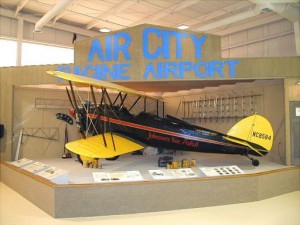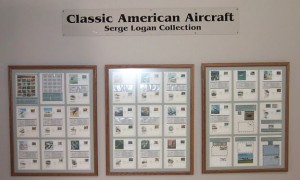MuseumWelcome to the EAA Chapter 838 museum. Our museum is a collection of airplanes, aviation memorabilia and Southeastern Wisconsin avialtion history. We are open by appointment, and during most Chapter 838 functions. Some of the features of our museum include:
WACO Taperwing & Ed Hedeen
In 1929, and again in 1931, Hedeen flew the plane on a 12,000-mile tour to distribute liquid wax to customers. Hedeen was a barnstormer and a world champion barrel roller. While on his tour for Johnson's, he participated in, and won many air cup races. During the time of his good will tour, airplanes were curious machines that attracted crowds. However, only very few aircraft were being used to promote a company's products. Ed Hedeen subsequently established Wisconsin's largest flying school at Air City Airport in Sturtevant. Alfred W. Lawson & the University of LawsonomyAfter an accident during its trial flight, the L-4 never flew again.
Model of a Lawson airliner design in the museum
Pacific J. "Fig" Landremann & Barnstorming
P. J. "Fig" Landremann was an early Barnstormer. At one time he attempted to set a world's record in the number of parachute jumps in one day. He failed due to a broken leg after jumping from dawn to almost dark. Fig was chief pilot for Jacobsen Manufacturing Company. Barnstormers were also known as boomers and sky pilots. The American craze of barnstorming was a form of aerial showmanship and stunt flying that reached its peak activity during the Roaring Twenties. Most of the stunt fliers were aerial combat veterans of World War I. The plane that made all of this possible was the Curtis JN-4D "Flying Jenny." This aircraft was popular among pilots due to its availability from the war surplus market. Fig Landremann was elected to the Southeast Wisconsin Aviation Hall of Fame in 1998. Horlick Racine Airport Beacon
Twelve years later in 1941, it became an airport beacon at the Horlick-Racine Airport. Beacons were placed in strategic locations coast to coast. They were known to early pilots as "the flashing beacons and the light line." The beacons might just as well have been called "life lines." Before they came on the scene, pilots flying airmail routes flew across unlighted airways. The rotating beacons were mounted on 70-foot towers and could be seen by pilots up to 40 miles in good visibility. On the same platform were two stationary course lights, one pointing forward and the other backward along the airway. These were 500-watt lamps that projected a beam of 100,000 candlepower and fitted with red or green lenses. A Military Legacy - Salute to Southeast Wisconsin Aviation PersonnelA log book pays tribute to persons from southeast Wisconsin who have served their country in aviation related assignments. More than two hundred service men and women are listed with photographs, articles, and information about their service years. This is an ongoing exhibit with names and information added as they become known. Kitfox IIThe Kitfox II aircraft was a gift to the museum from Dr. R. C. Feulner of Oconomowoc, Wisconsin. The Kitfox is one of many aircraft that come in kit form, and is constructed by amateur home builders. The Kitfox is a very popular design, as it is relatively quick to build and can get you into the air sooner than some more elaborate designs. Moody Ultralight
Subsequently, he attached a 12.5 horsepower West Bend engine to his Icarus II hang glider. On March 15,1975, west of Racine, he flew for 30 minutes in the first powered hang glider. Later, he added wheels to the aircraft. From all of this evolved the popular sport of ultralight aviation and the multitude of designs for personal lightweight aircraft. STAMPSAviation Pioneers on StampsOver a century ago, humans managed to lift themselves on wings from a sand dune at Kitty Hawk, North Carolina. When the Wright brothers flew for the first time in 1903, the era of powered flight began. Aviation is a very popular topic among stamp collectors worldwide. The four frames with 36 panels contain stamps and covers from around the world. They trace the history of aviation through the innovators and pioneers who made it happen, from the Wright Brothers at Kill Devil Hill to Armstrong and Aldrin landing on the moon. Classic American Aircraft Stamp ExhibitOn July 19, 1997, the U.S. Postal Service issued a sheet of stamps depicting a collection of Classic American Aircraft. The aircraft chosen for the set are representative of the first 50 years of powered flight in America. It is a chronicle of aviation history from the days of wood-framed, fabric-covered contraptions to high-flying supersonic jets. The 3 frame, 27 panel exhibit displays the first day covers created by acclaimed aviation artists such as Jack Fellows and Steve Ferguson. Secondary Issue of the Wright Flyer StampAs part of the ongoing marking of the centennial of powered flight, Chapter 838 participated in the second day issue of the Wright Flyer Stamp issued by the US Postal Service on May 23, 2003. The first day of issue was May 22nd at Dayton, Ohio. There were only five other postal stations participating in the second day issue nationwide, with Chapter 838 being not only one of the five, but the only EAA Chapter to participate. The chapter was approached in November of 2002 by the postmaster of the 4 Mile Road Racine post office. Designed by Bruce Renquist, the cancellation was unique for Chapter 838. Serge Logan hosted the cancellation at the 4 Mile Road post office. Along with the special Chapter 838 cancellation, pictures of the chapter's Wright Flyer and Wright Brothers memorabilia was displayed. Serge also brought along his collection of Wright Flyer stamps that have been issued throughout the world. Covers have long been sold out, and are now collector's items. Test Pilots - The Frontiersmen of FlightTest pilots are a select group. These aviators put unproven new planes through their paces at such places as NASA's Dresden Flight Research Center at Edward, California. Flight research and flight-testing are a vital component of aviation. Whenever an aircraft takes to the sky, it follows in the wake of the test pilot and flight test engineers. The three panel stamp exhibit shows a series of test flight events. These mark significant milestones made in test flights. |

 The 1929 WACO Taperwing is a two place open cockpit biplane. Powered by a Wright R-760 engine, the top speed of the aircraft was 135 miles per hour, using 12 gallons of fuel per hour. This plane was used by the SC Johnson company as a marketing vehicle and was flown by Johnson Company pilot, Ed Hedeen.
The 1929 WACO Taperwing is a two place open cockpit biplane. Powered by a Wright R-760 engine, the top speed of the aircraft was 135 miles per hour, using 12 gallons of fuel per hour. This plane was used by the SC Johnson company as a marketing vehicle and was flown by Johnson Company pilot, Ed Hedeen.








